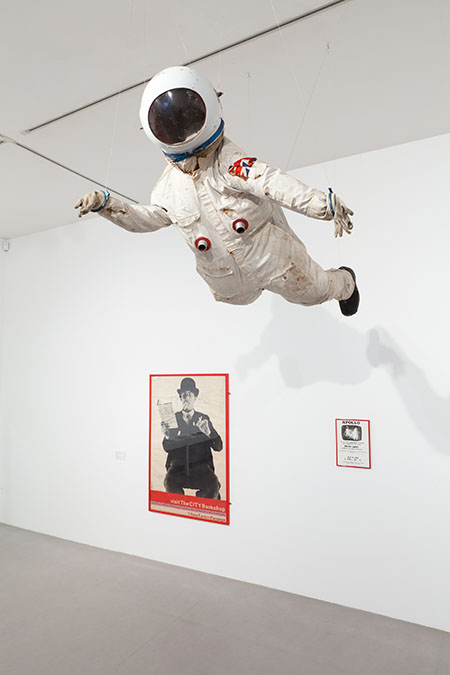Bruce Lacey

Tucked away on Fairport Convention’s 1969 album What We Did On Our Holidays is a psychedelic blues song called ‘Mr Lacey’. In the middle eight, if you listen closely, you can detect faint mechanical beeps and whirrs. These ‘noises off’ emanated from automata constructed by Bruce Lacey, the Fairport members’ near neighbour in Muswell Hill at the time, and an artist whose work, by the late ’60s, dwelt on the threshold of performance, sculpture, film, robotics, painting and environmental installation. ‘No one here understands now,’ runs the song’s closing line, ‘but maybe some day they’ll catch up with you.’ And now they have. ‘The Bruce Lacey Experience’, the largest survey of his multifarious activities to date, was shaped by the co-curation of David Alan Mellor and Jeremy Deller, another North Londoner whose interest in amassing archives and subverting public ritual owes a debt to Lacey’s example.
Spread across three gallery spaces and a vestibule, the show broke Lacey’s practice down into manageable chunks. An introductory display of posters located ‘Professor’ Lacey among the fringe entertainment scene, including ‘interruptions’ at a 1959 Albert Hall jazz festival, and his regular participation in ‘Evenings of British Rubbish’ during the ’60s: a kind of goonish, madcap, cod-Edwardian revue/Happening that clearly prefigured the English comic surrealism of Monty Python, Viv Stanshall, Spike Milligan et al, and later the alternative comedy of Reeves & Mortimer and The League Of Gentlemen. Appearances at the Roundhouse in Camden and at the radical Stratford Theatre Royal sucked him sideways into the underground scene, where his ‘humanoids’ – crude androids jerrybuilt from scrap metal, military hardware and medical/kitchen sundries – provided perplexing diversions at the era’s lysergic love-in. A 1967 trip to the prehistoric stone circle at Avebury helped him tune in to the secret archaeology of Albion, and his marriage to collaborator Jill Bruce speeded this ‘silly bugger artist’’s turn towards geomancy and ‘a deepening relationship with the mysteries of the earth’. Posters from the late ’70s advertise the couple’s ‘elemental co-ordinations’: attempts to tap into the species-memory of ritual and natural cycles within a wholly other, and somewhat forgotten, slice of underground culture – Faerie Fairs, Ariel Fairs, Fire Fairs, Moon Fairs.
The artefacts from Lacey’s shamanic rituals at such events, gathered in one room, proved to be the least successful in a gallery context. Tie-dyed outfits, pentagrams and cosmically inclined canvases veered close to New Age kitsch, animated only by video footage of his pyrotechnic interventions and ritualistic magic performances around a fire. The room of robots and humanoids, though, was stunning. Dating from between 1963 and 1965, these machines and assemblages, ‘expressing fears, love, hates, and feelings about society’, confronted you with an atavistic android primitivism whose moral force gestures towards the seven deadly sins: Lust (The Womaniser), Avarice (Old Moneybags) and Vanity (ROSA BOSOM, which eventually won the 1985 Alternative Miss World contest). To invoke the title of the ICA’s influential 1968 ‘Cybernetic Serendipity’ exhibition – in
which Lacey took part – his automata express the opposite: cybernetic zemblanity, or
an inexorable unearthing of negative traits in modern humanity.
A room filled with Lacey’s youthful memorabilia provided a counterpoint, tracing the developing sensibility of a youthful collector of fragments, an antiquarian who was nevertheless fascinated by the postwar machine age. Teenage sketches of aircraft parts, factory machinery and handbuilt models of V2 rockets testified to the fact that Lacey’s street was
hit by a flying bomb in World War II, an irruption that charged his later life and work with an urgency. His later route into shamanism and ritual could be understood as an escape route from the postwar heaviness that shadowed his first few decades.
But beneath the pizzazz of a ceiling-mounted wire-mesh penis spurting Sindy dolls, the most evocative object in the whole show was a small, battered handmade wooden fort, built by his father and used by Lacey as a boy to stage miniature siege re-enactments. It’s a tatty ruin whose frayed battlements seem to contain a lifetime of imaginative play and, as with so many of the artefacts on display, you found yourself marvelling that this resiliently fragile trinket could have survived its owner’s nomadic and eventful life to catch up with him again, here.
















